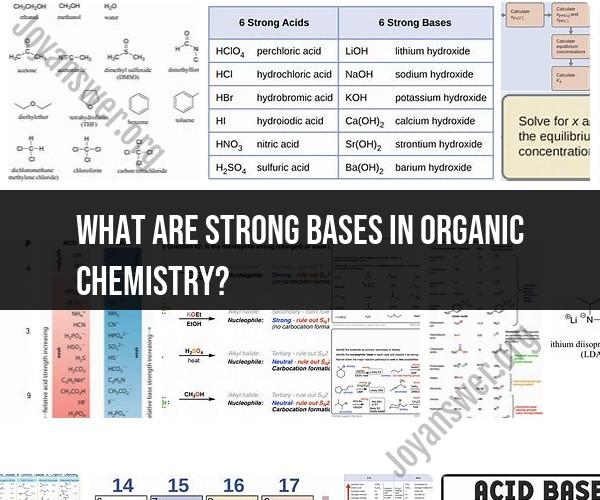What are strong bases in organic chemistry?
In organic chemistry, strong bases are substances that can readily accept protons (H+ ions) and have a high affinity for abstracting hydrogen ions from other compounds. Strong bases are often used in various chemical reactions to deprotonate or remove hydrogen ions from organic molecules. These reactions are essential for synthesizing and manipulating organic compounds. Here are some common strong bases used in organic chemistry:
Sodium Hydroxide (NaOH): Sodium hydroxide, also known as caustic soda or lye, is a highly potent strong base. It is often used in organic chemistry for reactions like nucleophilic substitutions and eliminations.
Potassium Hydroxide (KOH): Potassium hydroxide is another strong base closely related to sodium hydroxide. It is commonly used in organic synthesis, particularly in the preparation of alcohols from halides through the Williamson ether synthesis.
Sodium Amide (NaNH2): Sodium amide is a strong, non-metallic base that is useful for deprotonating acidic hydrogens in organic compounds. It is often used in reactions involving amine synthesis and other transformations.
Lithium Diisopropylamide (LDA): LDA is a powerful non-aqueous base used in organic chemistry, especially in reactions that require very strong basic conditions. It is particularly effective at deprotonating acidic protons adjacent to carbonyl groups in ketones and esters.
Sodium Hydride (NaH): Sodium hydride is a strong reducing agent and base used in various organic reactions. It is commonly employed to deprotonate acidic hydrogens in organic compounds and to generate hydride ions for reducing carbonyl compounds to alcohols.
Potassium tert-Butoxide (KOt-Bu): Potassium tert-butoxide is a strong base and nucleophile used in many organic reactions. It is especially useful in elimination reactions like the E2 elimination.
Sodium Ethoxide (NaOC2H5): Sodium ethoxide is a strong base and nucleophile frequently used in organic synthesis. It is often employed in reactions that involve the formation of ethers, esters, and other compounds.
Potassium tert-Amyloxide (KOt-Am): Potassium tert-amyloxide is a strong base commonly used in organic chemistry reactions, particularly in the synthesis of various organic compounds.
These strong bases are chosen based on the specific requirements of a given reaction, such as the desired reactivity, reaction conditions (solvent, temperature), and the nature of the organic molecules involved. It's essential for organic chemists to select the appropriate strong base to achieve the desired chemical transformations while considering factors like regioselectivity and stereoselectivity. Additionally, precautions must be taken when working with strong bases, as they can be highly reactive and caustic. Proper safety measures and protective equipment should always be used when handling these substances in the laboratory.












